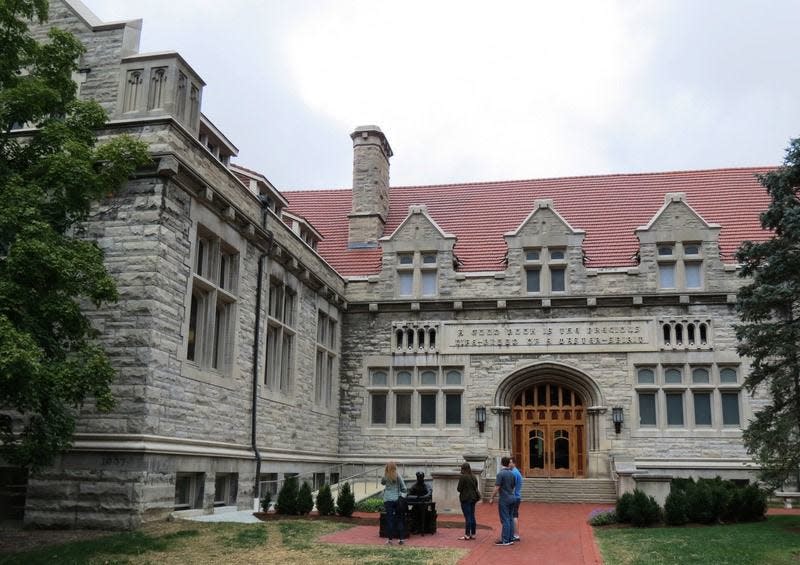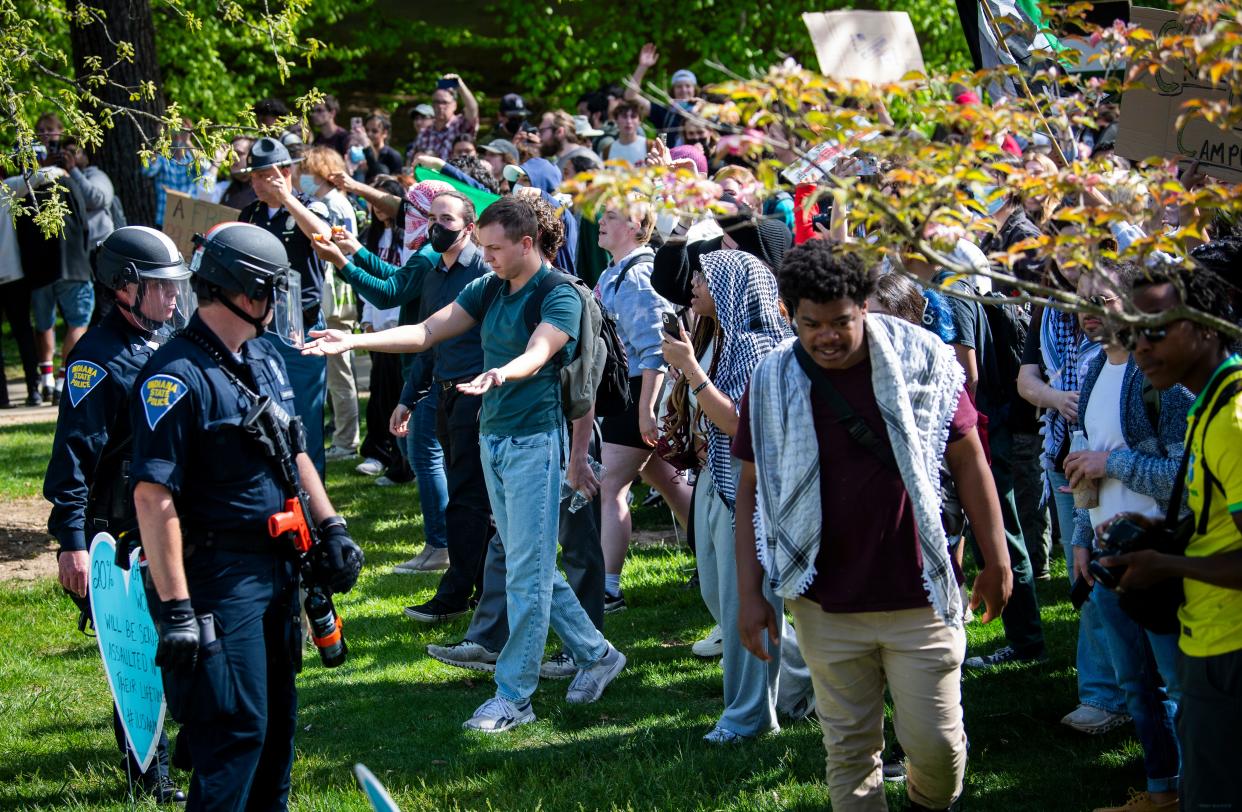'Our only option left': Fearing budget cuts from IU, the Indiana Daily Student steps out
On the day the pro-Palestinian encampment began at Indiana University’s Dunn Meadow — the same day Indiana State Police troopers arrested 33 demonstrators, and an eleventh-hour policy change from IU administration that was used to justify ISP’s actions came to light — the Indiana Daily Student (IDS), IU’s 157-year-old student newspaper, reported no news. Its office was closed, and its reporters and editors were on a walkout.

They hadn’t planned it that way. The week prior, days before the encampment was announced, the IDS’ spring editors-in-chief Nic Napier and Salomé Cloteaux published a letter from the editor announcing the one-day walkout on April 25, a move meant to raise awareness for what they saw as an existential threat to student media from IU’s administration. The headline read: “IU won’t support student media. The IDS will be walking out.”
“Over the years, the IDS has been forced to decrease professional staff, reduce the number of papers printed weekly and abandon opportunities to make money,” the letter read. “Our goal is to provide the community and the university a glimpse of a possible future without the IDS as it exists today — a future we are fighting to avoid.”
The IDS is in its third fiscal year of operating at a loss, accruing an approximate $900,000 deficit that remains untended to as the paper’s leadership pleads with the university to provide more financial support.
The walkout was meant to raise awareness for this. Still, they hadn’t imagined that their “glimpse” of a future without the IDS would occur on one of the most consequential days in recent IU history.
“Depending on your perspective, this was either the best day ever, or the worst day ever to have a walkout,” said Jim Rodenbush, the IDS’ director of student media.
Rodenbush was not involved in plans for the walkout but said he “wholeheartedly supported” the students’ efforts to raise awareness for the IDS’ financial situation. He said he shares the same concerns.
“There’s nothing like giant breaking news to show people the value of why you’re still around,” Rodenbush said.

The IDS did not fully abstain from reporting on April 25. Several reporters and editors were live-tweeting from the scene in Dunn Meadow, and by midnight of April 26, the paper had published a 2,000-word, 13 author byline report on the events of the day before. In the days that followed, the paper provided important follow-up reporting on the controversial policy change and the experiences of those detained and arrested by ISP and Indiana University Police (IUPD).
To leadership at the IDS, April 25 was a reminder of the student newspaper’s importance within the IU and local news ecosystem, and, they hoped, a wakeup call for IU to further support the paper.
“At this point, if we lose anything more, it’s gonna fundamentally change the IDS,” Cloteaux said.
“There’s a wide range of things that the IDS keeps the community informed about,” Napier said. “And each cut makes it more dangerous, and those things could go away.”
A long neglected problem at the IDS
April 17 wasn’t the first time the IDS published a letter from the editor concerning their financial situation. They’d first published a letter about their deficit in 2021, and published another in 2023 detailing a further neglected deficit and the difficulties in getting an answer from the IU administration and Media School.
“I would love for the IDS to get out of the business of letters from the editor,” Rodenbush said. “I hope we don’t have to write any more.”
The situation evolved each year, but the letters’ core message remained the same: The IDS was struggling, as victims of an industry-wide decline in print revenue and steadily declining university funding. To survive, leadership said, the paper would need increased support from the university.
The 2023 letter from former editor-in-chief Helen Rummel noted that the Media School was also on the eve of welcoming a new dean to the program, an administrative change that added anxiety to the existing budget issue.
“Whoever it ends up being will inherit a deficit of more than $500,000,” Rummel’s letter read. “I cannot say what they will decide to do with the IDS or our finances. Right now, none of us can.”
In January 2024, a few months into his role, new Media School Dean David Tolchinsky asked an ad hoc committee of Media School students, faculty and notable alumni to recommend proposals for how to make IU student media sustainable in the long-term, including the IDS, the student broadcast station IUSTV and the student radio station WIUX.
In the proposal, the dean asked the committee to consider a recommendation for turning student media entities into a 501(c)(3) nonprofit, similar to how IU controversially proposed handling the Kinsey Institute after a state amendment barred the research institute from receiving state dollars. In internal discussions, student leaders at the IDS also heard mentions of IU considering cutting professional staff (advertising experts and professional advisers who are some of the only non-student staff in the newsroom) who make up approximately 40% of the IDS’ budget.
Proposed Kinsey Institute change: Indiana University hasn't told Kinsey Institute researchers what trustees will vote on
Cloteaux said both ideas were alarming to leadership at the IDS.
“Around 2008, we had 11 professional staff members, and now we have five, who are still doing the job of 11 people,” Cloteaux said. “We can’t exist the way that we do now with any more cuts, and it’s been made clear to us that that’s still a likely possibility.”
In their final report submitted to Tolchinsky on April 1, the 16-member committee recommended consolidating student media under a single “umbrella” organization and asked the university to step up its short-term investments in student media, including restoring university advertising in student media that has declined in recent years, and increasing student fees to provide more investment.The proposal also looked at the state of student media across the country, noting that “very few, if any” student organizations at universities are expected to produce a profit, and noting that most student media organizations at public universities are funded via student fees and tuition.
“The continual withdrawal of IU campus-level support for the IDS, WIUX, and IUSTV, combined with the significant space taxes on the organizations, is out of step with national trends in student media operations and incompatible with IU’s 2030 Strategic Plan to guarantee and expand experiential learning for students,” the report said.
Tolchinsky called the report’s recommendations “innovative,” and said the Media School was working to “turn those recommendations into an operational plan.”
“The IU administration and I are fully committed to supporting student media,” Tolchinsky said. “We’re taking the recommendations, we’re looking at what we can put into operation, and we’re working really hard to make that into a plan.”
IDS leadership says there’s been ‘radio silence’ from IU
In the weeks since the report was turned over, IDS leadership says there’s been “radio silence” from Tolchinsky and IU administration, even as the paper begins putting together next year’s budget this summer.
Rodenbush, who served on the committee, says the lack of communication from Tolchinsky and IU administration has made him concerned that the university doesn’t plan to follow the recommendations, and further, that his position as a member of the professional staff could be at risk.
“If that’s what’s gonna happen, why not just say it?” Rodenbush said. “You can acknowledge that there are a lot of i’s to dot at t’s to cross, and I understand that. But if this is it, then what’s stopping you from saying as much?”
Napier said personal conversations between him, Tolchinsky and Cloteaux have also made him worry that IU is focused on further reducing the IDS’ budget and IU’s financial contributions, including a further reduction of professional staff.
“We’ve just been told (by administration), ‘We support student media, but there’s going to be tough financial decisions that have to be made,” Napier said. “When we have that messaging explaining to them what we need, for them to say, ‘This is still on the table, and you might just have to deal with it,’ it’s just really frustrating.”
Staff fears further cuts
Tolchinsky, who is in his eighth month at the Media School after serving as a professor and department chair for TV and film at Northwestern University, said he was caught off guard by the walkout announcement.
“The letter that was published kind of threw me for a loop,” Tolchinsky said. “I understand the frustration and the perceptions, because the discussions of the finances have been going on for years before me. But I came in, and I told the students that I don’t want to make decisions until I understand where I am and what the landscape is.”But for leaders of the IDS, especially in the same academic year the Kinsey Institute was almost severed from IU with little to no input from institute members, the anxiety of not knowing if or when a decision might be coming convinced them it was necessary to pull the alarm.
“We felt like we had reached a point where our only option left was to speak up and let the community know what was happening,” Napier said. “They’ve told us they haven’t made a decision yet and we don’t know when exactly a decision is gonna be made, but we wanted to be proactive and let the community know that these discussions are being had, and that we have heard about budget cuts, even though that would completely damage the IDS.”Rodenbush said while he remains optimistic about the outcome of the committee report and the actions Tolchinsky may take, he’s been disheartened by the years of the issue being “kicked down the road,” and worries that further cuts are likely to be made by IU.
“And I am admittedly a bit cynical with this process, because I’m coming up on my sixth year here,” Rodenbush said. “The professional staff, the ones that we have left, they’ve all been here for 20 years at least. So I think the frustration and cynicism is fair.”
Tolchinsky says throughout the process, he’s assured students and stakeholders that there’s no particular deadline for implementing the committee’s recommendations, though the 2024 fall semester has previously been discussed as a goal.
But Rodenbush says continuing “business as usual” as the IDS plans its budget this summer and enters into its fourth year of a building deficit makes him worry that drastic cuts could soon become an inevitability.
“‘Status quo’ means that we haven’t kicked the can down the road again, but we're winding up to do it,” Rodenbush said. “So until there’s clear communication, until there’s action, the words are just words.”
Reach Brian Rosenzweig at brian@heraldt.com. Follow him on X/Twitter at @brianwritesnews.
This article originally appeared on The Herald-Times: Indiana Daily Student walks out on day of protests due to fear of cuts
